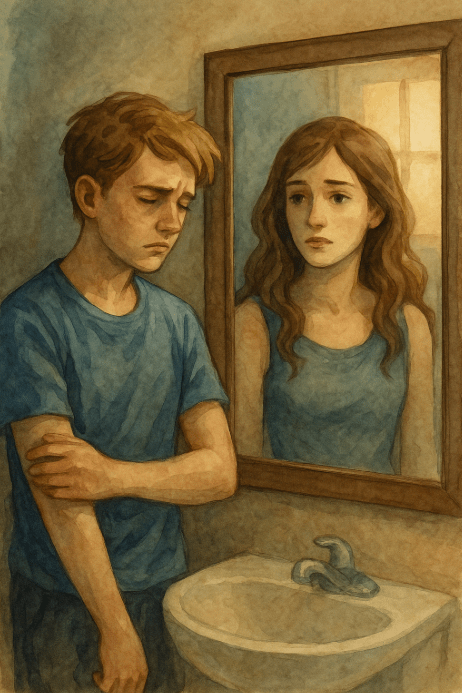Grieving Gender Dysphoria: Mourning the Battles You Cannot See
Grief with gender dysphoria is layered, mourning the body that feels like a prison and the life shaped by a world that refuses to understand.

This post blends real grief with grounded knowledge. It isn’t clinical. It isn’t distant. It’s meant to sit beside you—not above you. The story you’ll read is meant to reflect what so many feel when living through or witnessing this condition: confusion, exhaustion, and quiet forms of courage.
If what you read feels familiar, please speak with your doctor. Your pain deserves more than silence.
I Lost Them to a Body That Was Never Theirs
They always moved quietly around mirrors, as if they owed them something. Changing clothes in the dark, they’d turn their body away from their own shadow, as if it might betray them.
At first, I thought it was modesty or shyness. But I came to realize it was something much deeper…grief.
Not the kind that gets acknowledged with sympathy cards, but a slow, gnawing sorrow that sank beneath the skin, lingering quietly yet painfully.
They never outright expressed, “I’m in pain.” Instead, it was phrases like “I just don’t feel right” or “I wish I could unzip this.” I didn’t understand it at the time. I dismissed it as a phase, a metaphor, perhaps a storm they would eventually outgrow.
🧠 Symptoms:
- A strong, persistent desire to be another gender
- Discomfort with one’s physical sex characteristics
- A desire to be treated as another gender
- Conviction that one’s feelings and reactions are typical of another gender
- Distress or impairment in social, occupational, or other important areas of functioning
These symptoms can manifest in childhood and persist into adolescence and adulthood, or they may emerge later in life.
Yet it wasn’t a storm. It was the sky itself, a sky never meant for them.
I began to see that the weight they carried wasn’t merely emotional; it bore a physical heaviness as if gravity had chosen to crush them first.
They dreaded showers. Their voices would crack, triggering tears. They’d look at clothes as if every hanger mocked them.
In response, I tried to fix it with love and support—with assurances like “You’re beautiful no matter what.” But beauty wasn’t the focus.
It was about truth, about alignment; the harsh reality that their soul had been thrust into a narrative that wasn’t its own.
When they finally came out to me, there was no smile. Just sheer terror, as if revealing the truth could set off an explosion. They acted as though honesty had a price I might not be willing to pay.
Complications:
- Anxiety and depression
- Social isolation
- Substance abuse
- Self-harm and suicidal ideation
- Difficulties in relationships and occupational functioning
These complications often result from the distress associated with gender dysphoria and societal stigma.
Causes:
- The exact causes of gender dysphoria are not fully understood but are believed to involve a combination of genetic, hormonal, and environmental factors. Studies suggest that prenatal hormone exposure and genetics may play roles in the development of gender identity.
Initially, I faltered. Not in the obvious ways—I didn’t yell or shame them. But I hesitated, paused too long, and uttered, “Are you sure?” when I should have simply said, “Thank you.”
They had been sure for years. The uncertainty lay in whether the world would allow them the time to act on that certainty.
Afterward, they began to change, in ways I did not anticipate. It wasn’t about being louder or bolder; it was about being clearer. The static within their soul quieted, little by little. Hormones, clothing, names, and pronouns all played a part. Yet the ache? It didn’t disappear.
Some days, they grieve the childhood never experienced, the mismatched photographs, the puberty that overtook their body, the strangers who failed to see them, no matter how passionately they declared, “I’m me now.”
Risk Factors:
- Family history of gender variance
- Prenatal exposure to certain hormones
- Coexisting mental health conditions
- Experiences of trauma or abuse
I watch them carry that grief as if it were stitched into their very bones. I wish I could take it away, to erase the years that taught them to flinch whenever someone called them “ma’am” or “sir.”
I didn’t lose them to their transition; I lost them to the years spent surviving in a body that was never truly theirs.
Now I have them back, piece by piece. And every piece that fits? It belongs to them.
They didn’t become someone else…they finally became someone they could recognize.
📘 Diagnosis & Treatment
Diagnosis:
- Diagnosis is based on criteria outlined in the DSM-5, requiring a marked incongruence between one’s experienced gender and assigned sex, lasting at least six months, and causing significant distress or impairment.
Health
Treatment:
Treatment is individualized and may include:
- Psychotherapy: To explore gender identity and address associated mental health issues.
- Hormone therapy: To align physical characteristics with gender identity.
- Gender-affirming surgeries: Such as chest reconstruction or genital surgery.
- Social transition: Changing name, pronouns, clothing, and other gender expressions.
Support from healthcare professionals experienced in gender-diverse care is crucial.
Prevention:
- While gender dysphoria itself may not be preventable, early support and affirmation of an individual’s gender identity can mitigate associated distress and mental health complications.
-Verywell Health
I know this is heavy, and I understand that the road ahead may feel like a tangle of loss and unanswered questions. But please hear this: you are not broken because you are hurting; you are not weak because you are afraid. You are living through something real, and survival itself is a kind of grace. You are allowed to struggle, you are allowed to hope, and you are allowed to not have all the answers today. Whatever comes next, you do not face it empty-handed; you carry every moment of love that shaped you, and that will always be enough to keep going.
🎀 Gifts to help With Gender Dysphoria
🏥 Everyday Comforts for Everyday Battles
Managing Gender Dysphoria often means needing a little extra help.
Sometimes it’s about restoring dignity, ease, or simply getting through the day with less pain.
These carefully chosen tools aren’t just items; they’re small bridges back to living.
This section is about finding practical support, never shame.
Sleep Again Pillow System – Relief for the Chest That’s Been Through War
After top surgery, chest binding, or gender-affirming care, sleep becomes complicated. This multi-position pillow system supports the upper body, reduces pressure on healing tissue, and helps prevent accidental rolling or strain. It’s not just about posture—it’s about finally resting in a body you fought to call your own. Because healing shouldn’t be another form of dysphoria.
🌿 Paths to Healing Beyond the Map
Sometimes traditional medicine isn’t enough.
If you’re exploring gentle, alternative options to help with Gender Dysphoria,
you might find comfort in plant-based compounds like **CBD or CBG**.
*This section is not medical advice, just a door left open.*
USA Medical Stress Relief Total Pack – Soothing the System After Years of Tension
Gender dysphoria doesn’t only live in the mind—it wires itself into the nervous system. This Total Pack blends CBD with calming adaptogens and sleep support to help unwind the chronic tension that comes from masking, binding, waiting, and bracing. It doesn’t fix dysphoria. But it supports the soul that’s been holding too much, too long.
Need a Different Path Forward?
Every journey through grief looks different. Choose the next step that speaks to where you are now:
When You're Ready to Start Healing
Healing doesn’t mean forgetting.
It means finding small ways to carry your grief with strength and grace.
These are the stories, tools, and gentle steps to begin walking forward…at your own pace.
When You're Still in the Thick of It
Sometimes healing feels like a lie.
If you’re not ready to move on…if the pain still roars louder than the world wants to hear…this is the place where you’re allowed to feel it.
No sugarcoating. No pretending. Just truth.
When You're Holding on to Who’s Still Here
Grief reminds us to love louder.
If someone you love is still with you, this is your place to celebrate them, honor them, and create new memories while there’s still time.
Joy and sorrow can live side by side.






